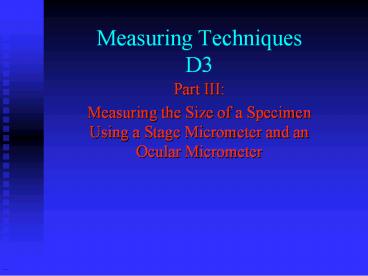Measuring Techniques D3 PowerPoint PPT Presentation
1 / 15
Title: Measuring Techniques D3
1
Measuring TechniquesD3
- Part III
- Measuring the Size of a Specimen Using a Stage
Micrometer and an Ocular Micrometer
2
Preface
- Before beginning this module, you should be
familiar with the parts, use, and care of the
compound microscope. - If you are unsure about the microscopes
operation, please review the Use of the
Microscope module. - Mishandling of the microscope can lead to damage
of the instrument.
3
Module Requirements
- To complete this module, the following equipment
will be provided to you by an SLC assistant. - -microscope with ocular micrometer
- -prepared microscope slide
- -stage micrometer
- -worksheet
- If materials are missing or you are having
problems getting started, please ask one of the
SLC staff for help.
4
Notes
- The Stage and Ocular Micrometer Technique is the
most precise method used for measuring
microscopic specimens here at the Science
Learning Center. - An ocular micrometer consists of an ocular lens
with equal space gradations that, unlike the
stage micrometer, have no units. - Look into the microscope at your workstation to
make sure you see the ocular micrometer. If you
dont see the micrometer, contact a Student
Assistant.
5
Notes
- If you have completed module D1, you should be
familiar with the stage micrometer. The modules
here at the Science Learning Center use a 2mm
micrometer. In lab situations though, always
check the label for the calibration.
6
- Position the stage micrometer on the
microscopes stage and clearly focus the scale
using the 10X objective lens. - Note If you are having trouble finding the scale
at 10X, switch to a lower power, such as 4X, to
center scale. Then select the 10X objective and
use the fine adjustment to focus.
7
Notes
- Though stage micrometers are very accurate, we
cannot place both a specimen on a slide and the
micrometer under the microscope at the same time. - To solve this dilemma, we can make use of the
ocular scale. Its important to remember that
the ocular micrometer divisions have no units,
and that each division will change with each
magnification. Therefore, you must calibrate the
ocular scale before you can use it.
8
Notes
- To calibrate the ocular scale, use the stage
micrometer. Your calibration will determine how
many millimeters are represented by one division
on the ocular scale, or one ocular division. - If you find that one ocular division equals
0.3mm, then you know two divisions equal 0.6mm
and so forth. - Therefore, if you find a specimen covers three
ocular divisions, you will know that it measures
0.9mm in length.
9
Calibration
- With the stage micrometer in focus, rotate the
eyepiece until the ocular micrometer aligns with
the stage micrometer.
This example shows that one ocular division (od)
equals 0.1mm.
10
Example
- Using the ocular division from our last slide,
we can measure the size of this animal. Based on
what you have learned, can you figure out its
length?
11
Example
- This animal occupies 3.4 ocular divisions.
We found that 1 od is equal to 0.1 mm. So the
size of this animal is 0.34mm. - The simple equation can be written as
- ( of ocular divisions) x ( of mm per division)
- diameter of cell in mm
12
Notes
- The last slide gave a quick example. Do not
take for granted that all ocular micrometers are
calibrated the same. Always calibrate your
instrument before making your measurements.
13
Example
- Suppose your microscope had an ocular lens
where one division equaled 0.02mm. You found
that your specimen covers 3 ocular divisions.
What is the length of your specimen? - (3) x (0.02mm) 0.06mm
14
Try it!
- Follow the procedure with the practice slides
provided. Remember its good practice to
calibrate your microscope for each specimen.
15
Module Completed!
- Please return to the main desk to obtain a post
test from your friendly Science Learning Center
personnel.

